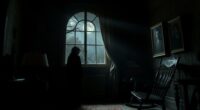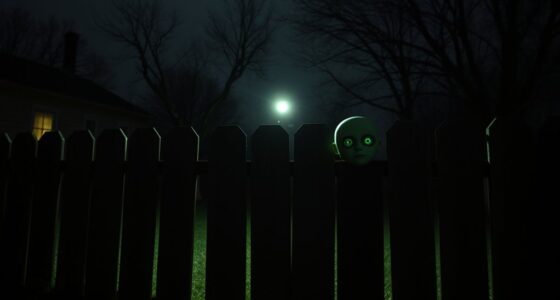The Brown Lady of Raynham Hall is a haunting figure steeped in tragedy. Known as Dorothy Walpole, she suffered under the cruel control of her husband, Charles Townsend. After dying from smallpox in 1726, her spirit reportedly roamed the halls, first seen in 1835. A famous 1936 photograph claimed to capture her ghostly image, but doubts linger. This enthralling story reveals more than just a ghost; it reflects deep emotional scars and historical intrigue. There’s much more to uncover.
Key Takeaways
- The Brown Lady of Raynham Hall is believed to be the ghost of Dorothy Walpole, who suffered a tragic life and death.
- First sighted in December 1835, her haunting has intrigued visitors and paranormal investigators for nearly two centuries.
- Charles Townshend’s cruel treatment of Dorothy contributed to her tragic legacy and subsequent ghostly presence at Raynham Hall.
- A famous 1936 photograph allegedly captured her apparition, sparking both fascination and skepticism among ghost enthusiasts.
- The Brown Lady’s tale has influenced literature and media, making Raynham Hall a popular destination for paranormal tourism.
Overview of the Brown Lady of Raynham Hall
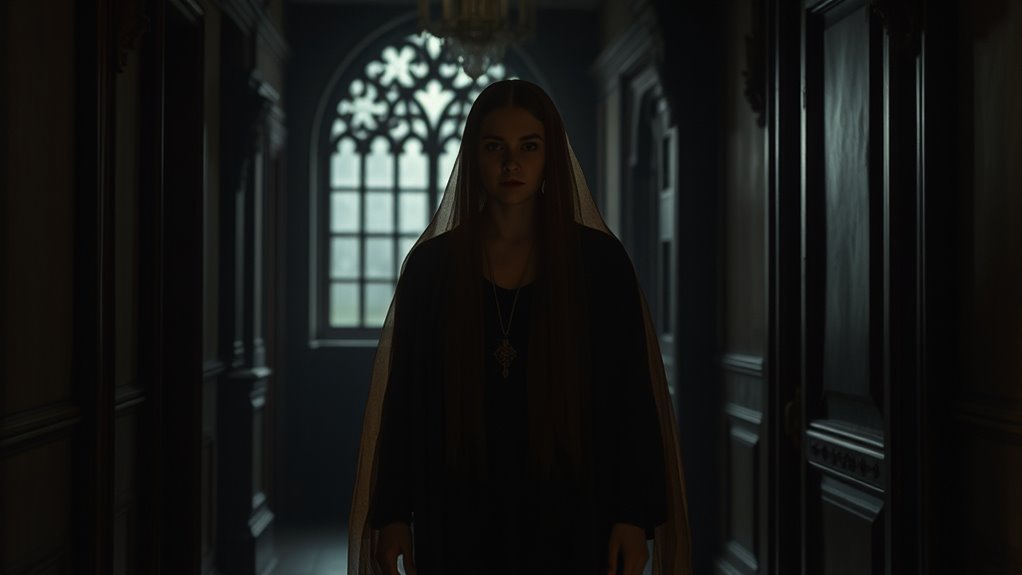
The Brown Lady of Raynham Hall is one of Britain’s most renowned ghosts, enchanting imaginations with her haunting presence. Identified as Dorothy Walpole, sister of the first Prime Minister, she’s often depicted in a flowing brown dress.
The Brown Lady of Raynham Hall, known as Dorothy Walpole, captivates with her ghostly allure in a flowing brown dress.
Sightings of this ghost date back to the 19th century, with the first recorded instance occurring in 1835. Witnesses describe her with eerie empty eye sockets, igniting curiosity and fear alike.
In 1936, a famous photograph claimed to capture the Brown Lady, though skepticism arose due to double exposure theories.
This haunting at Raynham Hall hasn’t only cemented her legacy but also sparked significant interest in paranormal investigations, drawing countless tourists and ghost enthusiasts keen to catch a glimpse of the spectral figure.
Identity of the Ghost
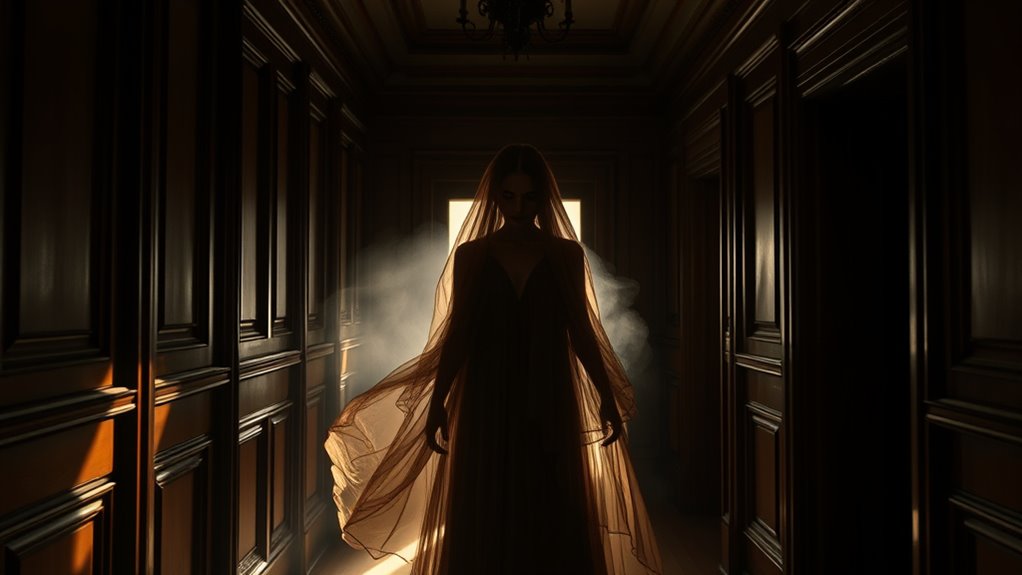
Identified as Dorothy Walpole, the ghost known as the Brown Lady of Raynham Hall embodies a tragic story rooted in her tumultuous life.
As the sister of Robert Walpole, the first Prime Minister of Great Britain, she suffered greatly under the control of her husband, Charles Townshend, whose violent temper and harsh treatment left her confined.
Rumors of an affair with Lord Wharton led to her imprisonment in Raynham Hall, where she ultimately succumbed to smallpox on March 29, 1726, without access to her children.
The ghostly apparition is often seen in a striking brown brocade dress, solidifying her haunting legacy.
The Brown Lady continues to be a poignant reminder of the heartache and struggles she endured.
The Life of Dorothy Townsend

Born on September 18, 1686, Dorothy Townsend grew up in a gentry family that had strong political ties, including her brother Robert Walpole, who’d become the first Prime Minister of Great Britain.
In 1713, she married Charles Townsend, the 2nd Viscount Townsend, and had six children with him. Her life, however, was marred by turbulent events:
- Aristocratic background: Dorothy’s lineage brought prestige.
- Political connections: Her family’s influence was significant.
- Infidelity accusations: Charles punished her severely for alleged unfaithfulness.
- Tragic circumstances: Dorothy died from smallpox on March 29, 1726, leading to the legend of the Brown Lady ghost at Raynham Hall.
Her haunting continues to captivate many, echoing the pain of her life.
Charles Townsend’s Cruelty
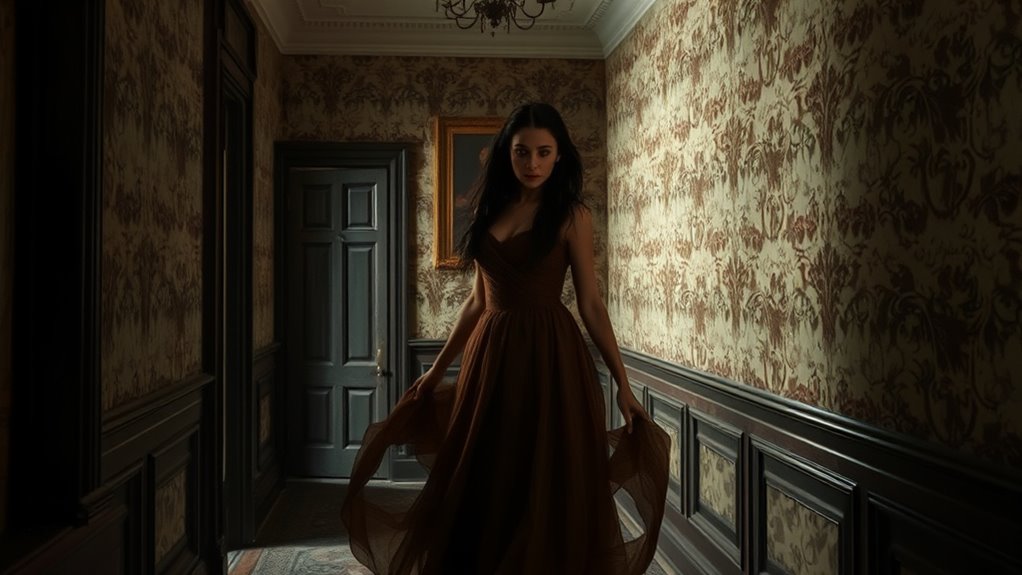
While many admire the grandeur of Raynham Hall, the dark legacy of Charles Townsend, the 2nd Viscount Townshend, casts a long shadow over its history. His violent temper created an oppressive environment for his wife, Dorothy Walpole. After punishing her for an alleged affair, he confined Dorothy to her rooms, isolating her from their children and the world. This cruel treatment deteriorated her mental and physical health, leading to her tragic death from smallpox in 1726. Speculation about her demise and the haunting associated with her spirit continues, as Charles Townsend’s harsh reputation lingers.
| Aspect | Detail |
|---|---|
| Husband | Charles Townsend |
| Wife | Dorothy Walpole |
| Cause of Death | Smallpox |
| Environment | Oppressive |
Sightings of the Brown Lady

As the legend of the Brown Lady grew, her sightings became an enthralling part of Raynham Hall‘s history.
You’ll find that these encounters are both fascinating and eerie:
- The first recorded sighting occurred in December 1835 with Lucia C. Stone and Colonel Loftus, who described her empty eye sockets.
- In 1836, Captain Frederick Marryat fired at the apparition, only to see the ghost vanish.
- The Brown Lady continued to appear throughout the 19th and 20th centuries, with a notable sighting reported in 1926.
- The most famous sighting was captured in a 1936 photograph, showing a ghostly figure descending the staircase of Raynham Hall.
These sightings have solidified her status as a compelling ghost within the legend of Raynham Hall.
The 1936 Photograph and Skepticism
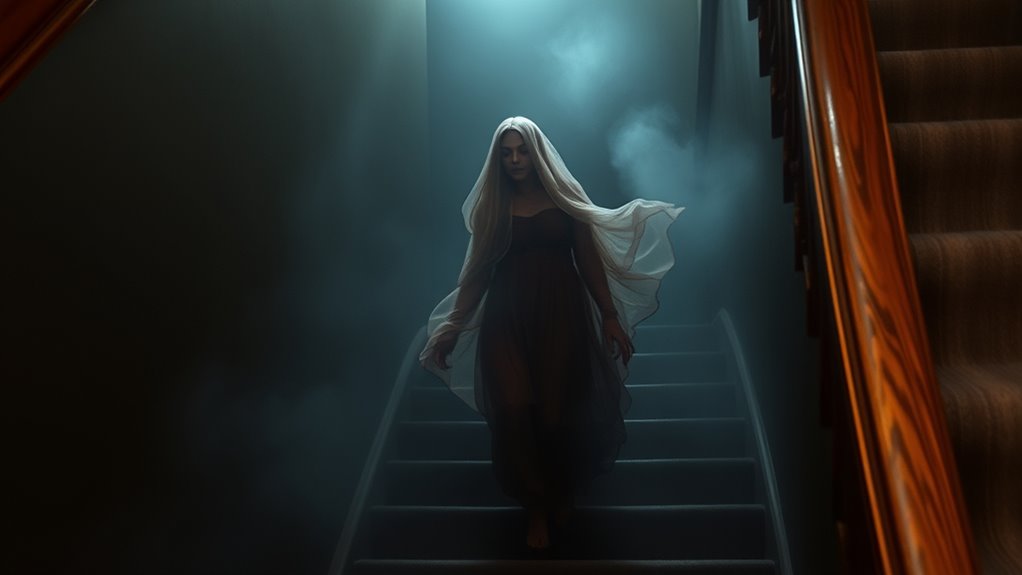
How did a single photograph ignite both fascination and skepticism surrounding the Brown Lady? Captured on September 19, 1936, by Captain Hubert C. Provand and his assistant Indre Shira, the photograph shows a ghostly figure descending the staircase of Raynham Hall.
Yet, critics quickly emerged, suggesting it might’ve been faked or suffered from accidental double exposure due to Shira’s movement. Joe Nickell pointed to evidence of double exposure, while John Fairley and Simon Welfare highlighted pale lines indicating superimposed images.
Magician John Booth even demonstrated how similar effects could be achieved using naturalistic methods, fueling ongoing skepticism about the photograph’s authenticity.
Despite this, sightings of the Brown Lady continue, leaving many to question her true existence.
Cultural Impact and Historical Context

The Brown Lady of Raynham Hall isn’t just a ghost; she’s a cornerstone of British ghost lore that blends history with the supernatural.
Her haunting has inspired various forms of media, from books to documentaries, highlighting how stories of the past shape our fascination with the paranormal.
As you explore her tale, you’ll see how Raynham Hall’s rich history enhances the intrigue surrounding her legend.
Ghost Lore Influence
While exploring the depths of British ghost lore, you’ll find that the Brown Lady of Raynham Hall stands out not only as a striking figure but also as a cultural icon.
Her story intertwines the tragic life of Lady Dorothy Walpole with supernatural elements, enchanting hearts since the 19th century.
Here are four key influences of her haunting narrative:
- Inspiration for Ghost Stories: The Brown Lady has sparked numerous tales in British ghost stories.
- Impact on Ghost Photography: The 1936 photograph by Captain Provand raised debates about authenticity in ghost photography.
- Tourism Boost: Raynham Hall attracts visitors drawn to its ghostly reputation.
- Cultural References: Various media highlight her status as a symbol of the intersection between history and the supernatural.
Historical Significance of Raynham
Situated in Norfolk, England, Raynham Hall not only serves as the ancestral home of the Townshend family since the early 18th century but also holds deep historical significance that intertwines with the eerie legend of the Brown Lady.
This ghostly figure is linked to Lady Dorothy Walpole, whose tragic story has shaped British ghost lore and sparked fascination with the supernatural.
Raynham Hall’s association with Robert Walpole, the first Prime Minister of Great Britain, further enhances its historical context.
The haunting narrative of the Brown Lady reflects real events from the 18th century, bridging history and the supernatural.
Cultural references to her have permeated literature and media, illustrating her lasting impact on ghostly folklore and the paranormal narrative in Britain.
Media Representation of Hauntings
How do media portrayals shape our understanding of hauntings like the Brown Lady of Raynham Hall?
The Brown Lady, rooted in the tragic story of Dorothy Walpole, has captivated audiences through various media representations that highlight her haunting narrative.
Key influences include:
- The 1936 ghost photography in Country Life magazine, which sparked debates on authenticity.
- Documentaries and articles that explore her historical context and personal tragedy.
- References in popular culture, emphasizing themes of lost love and vengeance.
- Reports of sightings fueling paranormal investigations and tourism at Raynham Hall.
These portrayals intertwine the supernatural with the cultural fabric, shaping our perceptions of hauntings and deepening our intrigue around the Brown Lady and her legacy.
Frequently Asked Questions
Who Is the Ghost in the Lady of Raynham Hall?
The ghost in the Lady of Raynham Hall is known as the Brown Lady. She’s often believed to be Dorothy Walpole, who faced a tragic fate in her own home.
Legends say she was confined by her husband due to alleged infidelity and later died from smallpox.
You might encounter her spectral figure, dressed in a ghostly brown gown, with haunting empty eye sockets that evoke both curiosity and dread among those who see her.
What Is the Most Famous Ghost Story in the World?
The most famous ghost story in the world often captivates your imagination with tales of hauntings and spectral encounters.
Many believe it involves tragic figures and unresolved conflicts, drawing you into their eerie narratives. You might find yourself intrigued by the countless sightings reported by witnesses, adding to the story’s mystique.
Whether it’s through a chilling photograph or firsthand accounts, these ghostly legends continue to fascinate and inspire curiosity across generations.
What Is the Brown Lady of Raynham Hall 1936?
Did you know that over 70% of people believe in ghosts?
The 1936 photograph of the Brown Lady of Raynham Hall is one of the most famous ghost images ever taken. Captured by Captain Hubert C. Provand, it shows a ghostly figure in a brown dress descending a staircase.
Despite skepticism surrounding its authenticity, this eerie image sparked widespread interest and continues to fuel legends about the haunting of Raynham Hall.
What Is the Story of the Lady in White Ghost?
The Lady in White ghost often tells a haunting tale of tragedy and loss.
You’ll find her wandering through historic sites, dressed in a flowing white gown that symbolizes innocence lost. Legends speak of unrequited love or wrongful death, leaving her spirit restless.
Many who’ve encountered her describe a chilling presence, feeling a deep sadness in the air. Her story captivates you, intertwining folklore with eerie encounters that echo through time.
Conclusion
In the shadowy halls of Raynham Hall, the Brown Lady continues to haunt our imaginations, a spectral reminder of a tragic past. You can almost feel her sorrowful gaze, like an eternal storm cloud hanging over the estate. As you walk the corridors, you’re not just stepping into history; you’re mingling with the echoes of a heartbroken soul. The legend endures, enchanting all who dare to glimpse the ghostly figure of Dorothy Townsend, forever lingering in the twilight.

